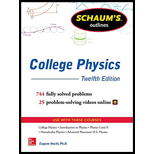
A motor furnishes 120 hp to a device that lifts a 5000-kg load to a height of 13.0 m in a time of 20 s. Find the efficiency of the machine.
The efficiency of a machine, considering the motor delivers a power of
Answer to Problem 10SP
Solution:
Explanation of Solution
Given data:
The power delivered by the motor to the device is
The mass of the lifted load is
The height to which the load was lifted is
The time taken to lift the load to the height is
Formula used:
The formula for efficiency of a machine is
Here,
The work done is calculated by the formula:
Here,
Power is calculated by the formula:
Here,
The formula for weight of a body is
Here,
Explanation:
Consider the expression for weight of the lifted load as
The standard value of
Substitute
Consider the expression for work done to lift the load to a height of
Here,
Substitute
Calculate the power delivered by the machine by the formula:
Here,
Substitute
Consider the expression for efficiency of a machine:
Substitute
Conclusion:
The efficiency of the machine is
Want to see more full solutions like this?
Chapter 7 Solutions
Schaum's Outline of College Physics, Twelfth Edition (Schaum's Outlines)
- Pls help ASAParrow_forwardPls help ASAParrow_forward9. When an electron moves into a uniform and perpendicular magnetic field, it will.. a. Accelerate parallel to the magnetic Field until it leaves b. Accelerate in a circular path c. Accelerate perpendicular to both the magnetic field and its original direction d. Repel back into the electric field 10. If a proton at rest is placed in a uniform magnetic field with no electric or gravitational field around, the proton will…….. a. Accelerate in the direction of the magnetic field b. Accelerate in a direction perpendicular to the magnetic field c. Move in a circular path d. Not acceleratearrow_forward
- 7. The electric field at a distance of 1.0 mfrom a charged sphere is 100 N/C. At what distance from thesphere will the electric field be 50 N/C? a. 1.1 m b. 1.4 m c. 2.0 m d. 4.0 m 8. The electric potential due to a point charge at a point depends on a. The direction of the electric field b. The distance from the point charge c. The velocity of the point charge d. The mass of the point chargearrow_forwardPls help ASAParrow_forward5. The amount of energy required to move 1 C of charge from one location to another is called.. a. Electrical Potential Energy b. Potential Difference c. Electric Field d. Mechanical Energy 6. If a charge of -q exerts a force of F on a charge +3q, then the charge +3q will exert a force of a. 3F b. -3F on charge -q. C. F d. -Farrow_forward
 Glencoe Physics: Principles and Problems, Student...PhysicsISBN:9780078807213Author:Paul W. ZitzewitzPublisher:Glencoe/McGraw-Hill
Glencoe Physics: Principles and Problems, Student...PhysicsISBN:9780078807213Author:Paul W. ZitzewitzPublisher:Glencoe/McGraw-Hill University Physics Volume 1PhysicsISBN:9781938168277Author:William Moebs, Samuel J. Ling, Jeff SannyPublisher:OpenStax - Rice University
University Physics Volume 1PhysicsISBN:9781938168277Author:William Moebs, Samuel J. Ling, Jeff SannyPublisher:OpenStax - Rice University Principles of Physics: A Calculus-Based TextPhysicsISBN:9781133104261Author:Raymond A. Serway, John W. JewettPublisher:Cengage Learning
Principles of Physics: A Calculus-Based TextPhysicsISBN:9781133104261Author:Raymond A. Serway, John W. JewettPublisher:Cengage Learning An Introduction to Physical SciencePhysicsISBN:9781305079137Author:James Shipman, Jerry D. Wilson, Charles A. Higgins, Omar TorresPublisher:Cengage Learning
An Introduction to Physical SciencePhysicsISBN:9781305079137Author:James Shipman, Jerry D. Wilson, Charles A. Higgins, Omar TorresPublisher:Cengage Learning Physics for Scientists and Engineers, Technology ...PhysicsISBN:9781305116399Author:Raymond A. Serway, John W. JewettPublisher:Cengage Learning
Physics for Scientists and Engineers, Technology ...PhysicsISBN:9781305116399Author:Raymond A. Serway, John W. JewettPublisher:Cengage Learning





